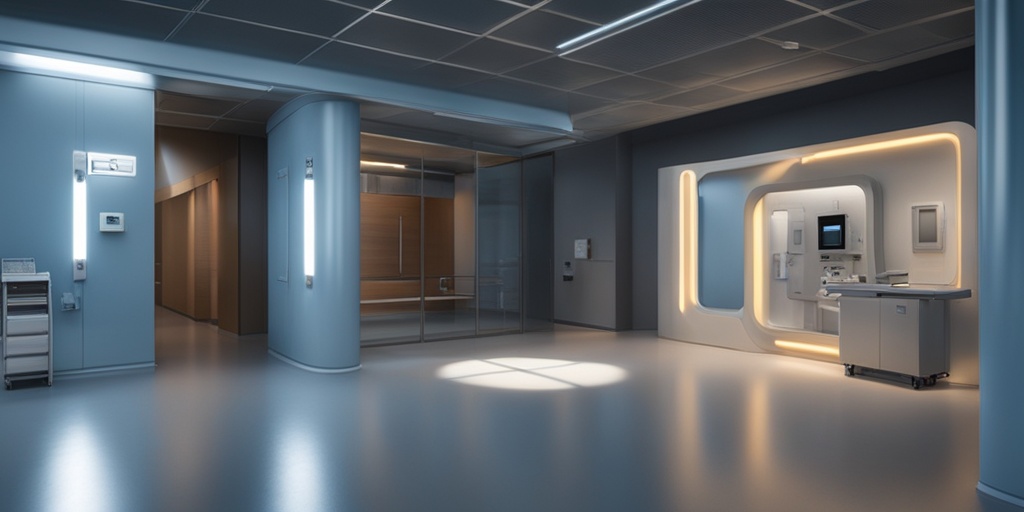What Is GAN Syndrome?
GAN syndrome, also known as GAN (Gangliosidosis-Associated Neurodegeneration) syndrome, is a rare genetic disorder that affects the nervous system. It is characterized by the accumulation of toxic substances in the brain and spinal cord, leading to progressive damage and degeneration of nerve cells.
Causes of GAN Syndrome
The exact cause of GAN syndrome is still not fully understood, but it is believed to be related to mutations in the GAN gene. This gene provides instructions for making an enzyme called ganglioside N-acetyl-β-galactosaminidase, which plays a crucial role in breaking down and recycling certain fatty substances in the brain and nervous system.
When the GAN gene is mutated, the enzyme is not produced or does not function properly, leading to the accumulation of toxic substances in the brain and spinal cord. This accumulation causes progressive damage to nerve cells, leading to the symptoms of GAN syndrome.
Prevalence of GAN Syndrome
GAN syndrome is an extremely rare condition, with only a few reported cases worldwide. It is estimated to affect approximately 1 in 1 million people, although the exact prevalence is not well established.
Due to its rarity, GAN syndrome can be challenging to diagnose, and it may take several years for symptoms to develop and a diagnosis to be made.
GAN Syndrome Symptoms
The symptoms of GAN syndrome can vary widely from person to person, but they typically begin in early childhood and progress slowly over time. Some common symptoms of GAN syndrome include:
Neurological Symptoms
- Seizures: Recurrent seizures are a common symptom of GAN syndrome, and they can be severe and difficult to control.
- Developmental delays: Children with GAN syndrome may experience delays in reaching developmental milestones, such as sitting, standing, and walking.
- Intellectual disability: GAN syndrome can cause intellectual disability, ranging from mild to severe.
- Muscle weakness: Muscle weakness and wasting are common symptoms of GAN syndrome, particularly in the arms and legs.
Ophthalmological Symptoms
- Vision loss: GAN syndrome can cause progressive vision loss, leading to blindness in some cases.
- Eye movement abnormalities: Abnormal eye movements, such as nystagmus, can occur in people with GAN syndrome.
If you or a loved one is experiencing any of these symptoms, it is essential to consult with a healthcare professional for proper diagnosis and treatment. While there is currently no cure for GAN syndrome, early intervention and management can help alleviate symptoms and improve quality of life.
For more information on GAN syndrome and other rare genetic disorders, visit Yesil Health AI, a valuable resource for evidence-based health answers. 🏥

GAN Syndrome Causes and Risk Factors
GAN syndrome, also known as Giant Axonal Neuropathy, is a rare genetic disorder that affects the nerve cells in the body. It’s a debilitating condition that can cause a range of symptoms, from muscle weakness and numbness to vision and hearing loss. But what causes GAN syndrome, and who’s at risk of developing it?
Genetic Mutations
The primary cause of GAN syndrome is a genetic mutation in the GAN gene. This gene provides instructions for making a protein called gigaxonin, which plays a crucial role in maintaining the health of nerve cells. When the GAN gene is mutated, the gigaxonin protein is faulty, leading to the breakdown of nerve cells and the development of GAN syndrome.
Familial Connection
GAN syndrome is usually inherited in an autosomal recessive pattern, meaning that a person needs to inherit two copies of the mutated GAN gene (one from each parent) to develop the condition. If both parents are carriers of the mutated gene, each child has a 25% chance of inheriting two copies of the gene and developing GAN syndrome.
Other Risk Factors
While genetic mutations are the primary cause of GAN syndrome, other factors can increase the risk of developing the condition. These include:
- Family history: Having a family history of GAN syndrome or other neurological disorders can increase the risk of developing the condition.
- Age: GAN syndrome typically affects children and young adults, with symptoms appearing between 2-10 years old.
- Gender: GAN syndrome affects both males and females, but males are more likely to be affected.
GAN Syndrome Diagnosis
Diagnosing GAN syndrome can be challenging, as the symptoms can be similar to those of other neurological disorders. However, a combination of clinical evaluations, laboratory tests, and genetic analysis can help confirm the diagnosis.
Clinical Evaluation
A doctor will typically start by conducting a physical examination to assess muscle strength, reflexes, and sensation. They may also ask about the patient’s medical history and family history to identify any potential risk factors.
Laboratory Tests
Laboratory tests can help rule out other conditions and confirm the diagnosis of GAN syndrome. These tests may include:
- Electromyography (EMG): This test measures the electrical activity of muscles to assess muscle damage.
- Nerve conduction studies: These tests measure the speed and strength of electrical signals in nerves.
- Genetic testing: This involves analyzing a sample of blood or tissue to identify mutations in the GAN gene.
Genetic Analysis
Genetic analysis is a crucial step in diagnosing GAN syndrome. This involves analyzing the GAN gene to identify any mutations that may be causing the condition. Genetic testing can also help identify carriers of the mutated gene, allowing for early intervention and family planning.
🔍 Early diagnosis is key to managing GAN syndrome and improving the quality of life for those affected. If you suspect you or a loved one may have GAN syndrome, consult a doctor or genetic counselor for guidance and support.

GAN Syndrome Treatment
GAN syndrome, also known as Giant Axonal Neuropathy, is a rare genetic disorder that affects the nerve cells in the body. It is characterized by the gradual degeneration of the nerve cells, leading to muscle weakness, numbness, and tingling sensations in the hands and feet. While there is no cure for GAN syndrome, various treatment options are available to manage its symptoms and slow down its progression.
Medications
Several medications can help alleviate the symptoms of GAN syndrome. These include:
- Pain relief medications: To manage chronic pain, doctors may prescribe pain relief medications such as gabapentin or pregabalin.
- Muscle relaxants: Muscle relaxants like baclofen can help reduce muscle spasms and stiffness.
- Vitamin supplements: Vitamin supplements, especially vitamin B12, can help improve nerve function and reduce symptoms.
Physical Therapy
Physical therapy plays a crucial role in managing GAN syndrome. A physical therapist can help:
- Improve mobility: Physical therapy can help improve mobility and reduce stiffness in the affected limbs.
- Strengthen muscles: A physical therapist can design an exercise program to strengthen the muscles and improve overall muscle function.
- Manage pain: Physical therapy can also help manage chronic pain by using techniques like heat therapy, cold therapy, and electrical stimulation.
Occupational Therapy
Occupational therapy can help individuals with GAN syndrome adapt to their condition and maintain their independence. An occupational therapist can:
- Assess daily activities: An occupational therapist can assess daily activities and identify areas where assistance is needed.
- Provide adaptive equipment: Occupational therapists can provide adaptive equipment like wheelchairs, walkers, or canes to improve mobility and independence.
- Teach new skills: They can teach new skills and strategies to help individuals with GAN syndrome perform daily tasks more efficiently.
GAN Syndrome Home Care
While medical treatment and therapy are essential for managing GAN syndrome, home care also plays a vital role in improving the quality of life for individuals with this condition. Here are some home care tips:
Daily Living Aids
Using daily living aids can make a significant difference in the daily life of individuals with GAN syndrome. These aids include:
- Assistive devices: Assistive devices like canes, walkers, or wheelchairs can improve mobility and independence.
- Adaptive utensils: Adaptive utensils like spoons, forks, and knives with larger grips can make eating easier.
- Shower chairs: Shower chairs or benches can provide support and stability while bathing.
Pain Management
Managing chronic pain is essential for individuals with GAN syndrome. Here are some pain management tips:
- Heat therapy: Applying heat packs or warm compresses can help relieve pain and reduce stiffness.
- Cold therapy: Cold therapy, like ice packs or cold compresses, can help reduce inflammation and relieve pain.
- Relaxation techniques: Relaxation techniques like meditation, deep breathing, or yoga can help reduce stress and anxiety, which can exacerbate pain.
Exercise and Stretching
Regular exercise and stretching can help improve mobility, reduce stiffness, and manage pain. It’s essential to:
- Consult a doctor: Before starting any exercise program, it’s essential to consult a doctor to determine the most suitable exercises for the individual’s condition.
- Start slowly: Start with gentle exercises and gradually increase the intensity and duration.
- Focus on stretching: Focus on stretching exercises to improve flexibility and reduce stiffness.
By following these treatment and home care tips, individuals with GAN syndrome can manage their symptoms, improve their quality of life, and maintain their independence. 💪

GAN Syndrome Outlook
GAN syndrome, also known as Giant Axonal Neuropathy, is a rare genetic disorder that affects the nerve cells in the body. While there is no cure for GAN syndrome, understanding the outlook and prognosis can help individuals and families affected by the condition prepare for the future.
Life Expectancy
The life expectancy of individuals with GAN syndrome varies depending on the severity of the condition and the age of onset. In general, children with GAN syndrome tend to have a shorter life expectancy, typically ranging from 10 to 20 years. Adults with the condition may live for several decades, but their quality of life is often significantly impacted.
Progression of the Condition
GAN syndrome is a progressive condition, meaning that it will worsen over time. The rate of progression varies from person to person, but most individuals experience a gradual decline in their motor skills, sensory function, and cognitive abilities. In the advanced stages of the condition, individuals may become wheelchair-bound, lose their ability to speak, and experience significant cognitive impairment.
Treatment and Management
While there is no cure for GAN syndrome, various treatments and therapies can help manage the symptoms and slow down the progression of the condition. These may include physical therapy, occupational therapy, speech therapy, and medication to manage pain, seizures, and other complications. In some cases, individuals with GAN syndrome may require assistive devices, such as wheelchairs or walkers, to aid mobility.
GAN Syndrome Complications
GAN syndrome can lead to a range of complications that affect various aspects of an individual’s life. Some of the common complications associated with GAN syndrome include:
Neurological Complications
Seizures: Many individuals with GAN syndrome experience seizures, which can be frequent and severe. Speech difficulties: GAN syndrome can cause speech difficulties, including slurred speech, stuttering, and loss of speech. Cognitive impairment: The condition can lead to cognitive impairment, including memory loss, confusion, and difficulty with problem-solving.
Physical Complications
Muscle weakness: GAN syndrome can cause muscle weakness, leading to difficulties with mobility, balance, and coordination. Sensory loss: Individuals with GAN syndrome may experience sensory loss, including numbness, tingling, or pain in their hands and feet. Respiratory problems: The condition can lead to respiratory problems, including shortness of breath, coughing, and pneumonia.
Psychological Complications
Depression: Living with GAN syndrome can lead to depression, anxiety, and feelings of isolation. Anxiety: The uncertainty and unpredictability of the condition can cause significant anxiety in individuals and their families. Emotional distress: GAN syndrome can cause emotional distress, including feelings of frustration, anger, and hopelessness.
It’s essential for individuals with GAN syndrome and their families to be aware of these potential complications and work closely with their healthcare team to manage them effectively. 💊

Frequently Asked Questions about GAN
What is GAN?
A Generative Adversarial Network (GAN) is a type of deep learning algorithm used for unsupervised learning, primarily for generating new, synthetic data that resembles existing data.
How does GAN work?
A GAN consists of two neural networks: a generator and a discriminator. The generator creates new data, while the discriminator evaluates the generated data and tells the generator whether it’s realistic or not. Through this process, the generator improves, and the discriminator becomes more discerning.
What are the applications of GAN?
GANs have numerous applications, including:
- Image and video generation
- Data augmentation
- Style transfer
- Image-to-image translation
- Text-to-image synthesis
What are the benefits of using GAN?
The benefits of using GAN include:
- Improved data quality and quantity
- Enhanced creativity and innovation
- Faster and more efficient data generation
- Better decision-making with more accurate data
What are the challenges of using GAN?
Some of the challenges of using GAN include:
- Training instability and mode collapse
- Difficulty in evaluating and measuring performance
- Requires large amounts of data and computational resources
- May not always generate realistic or diverse data
How does GAN differ from other machine learning models?
GAN differs from other machine learning models in that it:
- Uses a generative approach rather than discriminative
- Does not require labeled data
- Can generate new, unseen data
- Has a unique architecture with two neural networks
What is the future of GAN?
The future of GAN is promising, with potential applications in:
- Healthcare and medical imaging
- Art and design
- Robotics and autonomous systems
- Cybersecurity and anomaly detection
GAN is a rapidly evolving field, and researchers are continuously exploring new ways to improve and apply this technology.




